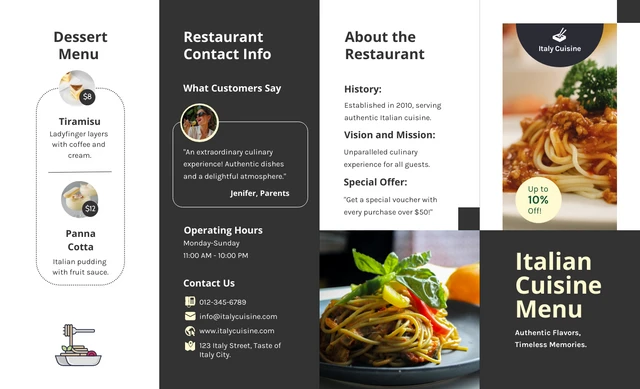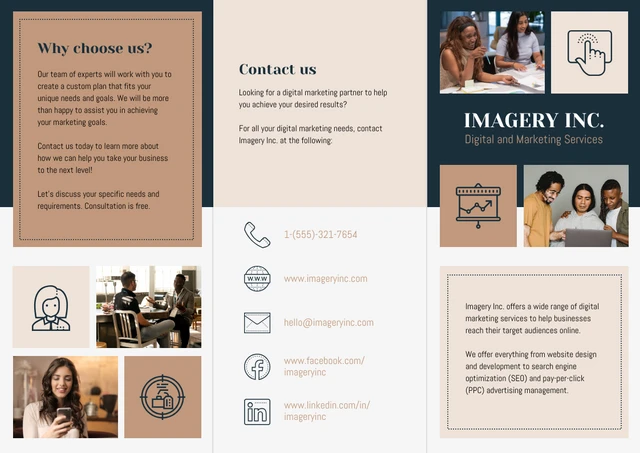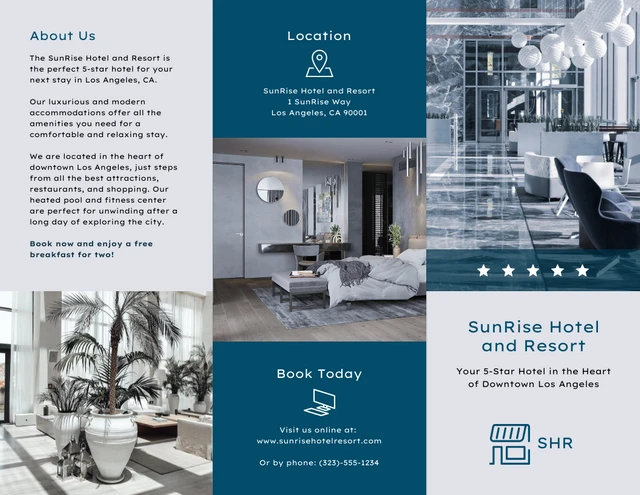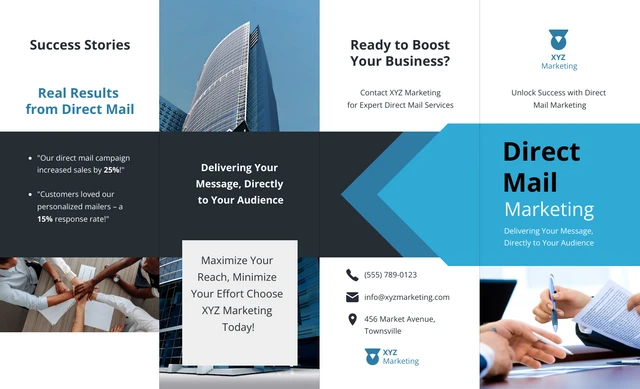
If you had to choose only one marketing tool to promote your products or services, which one would you pick? For me, it would be brochures. They are cost-effective, engaging, and grab attention.
You can use brochures to market products and services, promote events, spread awareness, or even build brand identity.
However, many businesses don’t use brochures correctly. Content is often misaligned and the design looks disrupted mostly because of selecting the wrong brochure size.
In this blog, I’ll teach you how to choose the right brochure size.
Pro-tip: You can use Venngage’s free Brochure Maker or brochure templates to make a brochure.
Click to jump ahead:
- Standard brochure sizes
- Choosing the right fold
- Choosing the right size
- Beyond standard sizes
- Pick an appropriate brochure in Venngage
- Conclusion
Standard brochure sizes
A well-designed brochure should have a solid harmony between the design and the content.
And this is why brochure size matters. It creates a logical flow of information because content and design are clearly visible.
Standard brochure sizes across most industries are:
- 8.5” x 11” — Letter size
- 8.5” x 14” — Legal size
- 5.5” x 8.5” — Memo size
- 9” x 12” — Arch A size
- 11” x 17” — A3 size
- 11” x 25.5” — Tri-fold brochure size
US standard sizes (in inches)
In the US, the following three brochure sizes are common.
1. Letter size (8.5″ x 11″)
Letter-size brochures are general-purpose brochures, used for mass distribution. They include information related to products and services.
I prefer letter-size brochures for professional events because they are compact and can easily fit in folders. They are also suitable for email campaigns.
2. Legal size (8.5″ x 14″)
A legal-size brochure is lengthier than Letter-size. Pick this size when you want more text or large images in a brochure. Legal-size brochures can be used as bi-fold, tri-fold, and even Z-fold brochures.
The most common use cases for legal-size brochures are real estate listings, promoting services, or event marketing.
3. Tabloid size (11″ x 17″)
If you want a landscape brochure design, go with tabloid size. It offers ample space for images and texts. You’ll usually see tri-fold, bi-fold, and gate-fold brochures in tabloid size.
Tabloid-size brochures work great for the travel and tourism industry and product catalogs.
International standard sizes (in centimeters)
If US brochure sizes don’t suit you, give international standard sizes a try.
1. A4 (21cm x 29.7cm) – the most widely used size globally
A4-size brochures are common in Europe and regions other than North America. They have a spacious layout and easily fit large content and visuals.
A4 brochures are compatible with printers so you can use them for business brochures, product catalogs, educational material, or to provide healthcare information.
2. A5 (14.8cm x 21cm) – smaller, more portable format
A5 brochures are my favorite. They are compact and can fit in anywhere. But, A5 brochures usually work best if you want to keep minimal text and visuals. Otherwise, the brochure looks chaotic.
You can use A5 brochures for mini catalogs or event invitations.
Choosing the right fold: enhance your brochure design
Let’s see what sizes are commonly used for different types of brochure folds.
1. Half-fold (8.5” x 11” or 8.5” x 14”)
Planning to design a professional brochure? You can’t go wrong with the half-fold or bi-fold style. A half-fold brochure simply folds a sheet of paper into two equal panels. You can arrange large texts and visuals easily on both back and front aides.
Half-fold brochures have a simple layout and are cost-effective as well. You can use Letter, Legal, or Tabloid brochure size to create a half-fold brochure.
2. Tri-fold (8.5″ x 11″ or A4)
If you want more sections, switch from bi-fold to tri-fold. In these brochures, sheets are folded to create three panels. You can use them to share provide step-by-step guides or share restaurant menus.
Three-fold brochures usually follow Letter size, Legal size or A4 size.
3. Z-fold (3.5″ x 8.5″ or 10.5cm x 21cm)
Z-fold or Zig-zag brochures are also very common. In these brochures, three panels are folded to create a Z shape. Since there are multiple sections, you can add individual services in each section and make the content more engaging.
Like other brochure styles, Z-fold brochures are usually available in Letter, Legal, Tabloid, and A4 sizes.
4. Gate fold (8.5″ x 11″ or A4)
Another brochure style you can follow is the gatefold format. In this brochure type, the panels on each side of the sheet are folded inwards and appear as gates for the main panel.
These brochures work great for event invitations and corporate presentations. You can use Letter, Legal, A4, and Tabloid sizes for gatefold brochures.
5. Double gate fold (8.5″ x 11″, 11″ x 17″ or A4)
In double gate fold brochures, the side panels fold inside twice. This way, you get a large central section to add wide texts or designs.
These brochures work best for real estate, business marketing, portfolio display, and product catalogs. The sizes for double gate fold brochure cafe are A4, Tabloid, and Letter sizes.
6. Double parallel fold (8.5″ x 11″, 11” x 25.5” or A4)
Want to create a brochure for a restaurant menu or an instructional manual? Try the double parallel fold.
You fold these brochures once into half and then refold it into half, in the same direction so there are two parallel folds and four sections.
These are large-sized brochures with comprehensive details. Double-parallel fold brochures are usually available in Letter, A4 and tri-fold brochure sizes.

7. Accordion fold (8.5″ x 11″ or A4)
An accordion fold brochure represents a zig-zag pattern in the form of an accordion. They have multiple panels and each panel can be used as a separate section to share information.
You can use accordion-fold brochures for menus, travel maps and itineraries, instructional manuals in multiple languages, and project or business timelines. Use custom size, A4, or Letter size for accordion-fold brochures or try A4 or Letter size.
8. Roll fold (8.5″ x 11″, A4 or A3)
Roll-fold brochures are another simple type in which you fold continuous strips of the brochure (in equal sizes) like a scroll.
You can use these brochures for marketing and promotional services where you describe one service in one section. I have even created company profiles with the roll-fold brochure.
The common sizes for roll-fold brochures are Letter size, A4, and A3 size.
9. French fold (8.5″ x 11″ or A4)
In French fold brochures, you first fold the brochure horizontally and then fold it again vertically. This creates four panels or quadrants that you can use to highlight different products or services, add price lists, mention your business USPs, or create a travel guide.
The common page sizes for French fold brochures are A4 and Letter size.
Related: How to Make a Brochure in Microsoft Word
Choosing the right size: factors to consider
Now that you know different brochure sizes, I’ll share four factors that can help you pick the right brochure size.
1. Content volume and design
If your brochure has too many visuals, pick a larger size, such as A4 or tabloid. If you want to keep the content minimal and catchy, small sizes, such as A5 work the best.
2. Target audience
Next comes your target audience. If you want to share detailed brochures with your customers, it’s better to go with A4 size. However, if you are targeting a specific audience, you can use a custom size.
For example, using a custom size for an AI and ML learning brochure can help you get more engagement.
Moreover, if your target audience is professionals, an A5 or tri-fold size template works better because it is compact.
3. Budget and printing costs
Brochure size also depends on the design budget and printing costs. Larger sizes such as 11″ x 25.5″ (tri-fold brochure) are costlier to design and print. However, A4 size brochures are more cost-effective because they are commonly used for printing any material.
4. Distribution mode
Lastly, consider the distribution channel to select the right brochure size. If you want to send the brochure through mail, it should easily fit in an envelope. In this case, you would need Letter size (8.5” x 11”).
If you want to email a brochure, the maximum width should be 600 px. In case of brochures for social media, go with the portrait size (1080 x 1350 px).
Beyond standard sizes: custom brochures
While designing a brochure, remember that standard sizes are only for guidance. There may be instances where standard sizes may not work well. In that case, you can use custom brochure sizes depending on your project purpose and distribution channel.
Let’s say you want to make your real estate company stand out from your competitors. You try to create a house-shaped brochure. Now, a standard brochure size will not work here and you will use a custom size as per the brochure design.
Pick an appropriate brochure size with Venngage
Venngage is a powerful design solution that helps you create engaging visuals to make communication simpler and more engaging.
You can use Venngage brochure templates to design appealing brochures within minutes using a drag-and-drop editor.
Try different brochure sizes to see which works best for your design and content. I am sharing the step-by-step process below to customize brochure sizes on Venngage:
- Step 1: Pick a brochure template and click on ‘Create the template’.
- Step 2: Now, go to the page size option on the top menu.

Once you click on ‘page size’, you will see multiple options for the brochure size. Select an appropriate size, such as tabloid, letter, A4, or A5.

- Step 3: If you don’t want to go with traditional sizes, you can even use custom sizing for brochures.

In fact, you can switch between portrait and landscape mode for the brochure in just one click.

Conclusion: Design visually appealing and informative brochures with Venngage
I know brochure size can seem trivial. However, a brochure with inappropriate sizing becomes less appealing and make the content ineffective and even leave a bad impression on customers.
Earthweb editor Jason Wise puts it like this: “Choosing the right brochure size is crucial for effective communication. It ensures your content is well-presented, visually appealing, and tailored to your audience. Choose wisely if you want to maximize your message’s impact and avoid unnecessary costs.”
Also, I’m sure you don’t want to go through the pain of changing the design or content and reprinting. So, it’s best to pick the right brochure size from the start and save time and costs.
Venngage’s brochure templates can help you here. Browse our library and pick a template based on your business requirements.












































